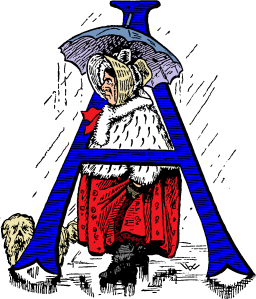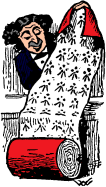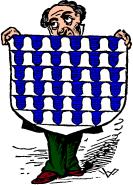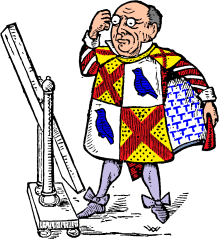HOME
Preface
Introduction
1
2
3
4
5
6
7
8
9
10
11
12
13
14
15
16
17
18
19
20
21
22
23
VI
CHAPTER VI.
OF FURS, &c.
FTER the Heraldic Tinctures come Furs, though why, except on the principle that tinctures are generally taken cold without, whereas furs, on the other hand, are generally warm within, we are unable to say. Furs are, therefore, to be found in Heraldry as well as Hudson's Bay, though it is a mistake to imagine that the beaver of the ancient knights had anything to do with them, as that was a part of the helmet or casque, so called from the various tappings it received, and to make a very obvious, though atrocious, pun, it was fur otherwise.
Furs may be divided into two kinds, "ermine" and "vair," the latter as a Scotch Herald, Sir George Mackenzie pertinently observes, "being vairy different from the former." These again, probably, on the principle that you cannot have too much of a good thing, are further subdivided, reminding us somewhat of an Irishman's farm before the landlord and the other encumbrances have been shot off the premises.
Ermine, heraldically described, is drawn on a "field argent, sable," or black on a silver ground, and consists of three black spots and tails to match, though who the inventor, or we should say author, of these tails may have been, is unknown; but the probability is, he was a bit of a wag, as the device bears as much resemblance to a real ermine as does a pair of boots to a methodist hymn. Each row of spots is called a "timber," but our readers would be a deal bored ere we should succeed in explaining how the name arose. The tails are denominated "muschetors," although the folly of eating mush, whatever it may be--and it don't sound nice--with a tail, is an absurdity that could only exist in Heraldry.
Ermine is a fur of great dignity, and only borne in the arms of royalty and nobility; from which we may infer that, should a commoner happen to catch an ermine running loose about Regent's Park, he must at once put it in his pocket, as he would not be of sufficient rank to bear it in his arms. By some writers the ermine is considered to be an emblem of purity, as it is said to prefer death to soiling its fur: all we can say on the subject, is, more fool the ermine; but the story, like the animal, to use the language of an ancient writer, "won't wash," and so we will leave this "ridiculus mus armenius" beneath the mountains of lies which old chroniclers have laid upon it.
Next comes the Variations, 1. "Ermines," which are precisely the same as ermine, only different, for the field is sable and the spots and tails argent. 2. "Erminois," our old friend spots and tails again; but this time they appear in black upon a field or, or a gold field, where, however, there are no diggings. 3. "Pean," spots and tails in gold, on a sable field. 4. "Ermenites," the same as the original ermine, only with one black and two red tails. This ought to be used by literary aspirants, who could thus boast of possessing two read tales.
The second kind of fur "Vair," is represented by small skins in the shape of cups, and usually in six rows. Placing the cups in connexion with rows argues great knowledge of human nature, and shows that the Heralds were, after all, not such fools as they looked, whatever ribald jesters may think of their appearance now-a-days when, discarding the coat and waistcoat of private life, they burst upon the astonished gaze of the public as Y-e Herald of Y-e Olden Times.
To return, whoever, to our cups. They were depicted "on a field argent, azure." Some etymologists, from the skin rather resembling a wine glass, derive the word "vair" from the French "verre," but this glass throws a reflection upon our common sense if we place any credence in it; and we are, therefore, obliged to put our foot down on it at once. The word, however, is probably derived from the Latin "varius;" nevertheless, should any of our readers be discontented with this derivation, as we have no desire to restrict their choice, they can suit themselves with any other they like to discover.
Vair has two variations; 1. "Vair en Point," when the cups are placed downwards, instead of topsyturvy, as in vair; and 2, "Counter Vair," which is not connected with either prize-fighting or shopkeeping, but is, when the cups are placed base to base, a kind of double base, concerted by the band of Heralds.
In addition to the foregoing furs, there is another, which, though classed among them, has, properly, no right to occupy that position ; in fact, it is a species of Heraldic duckling, which has intruded itself into the fur chicken's nest. The plan upon which the inventors seem to have worked was this : when a new cognizance was discovered strikingly different from anything else that had appeared, not knowing where to place it, they put it at once among that class to which it bore the least resemblance. On no other principle can we account for the "Potent," as this cognizance is called, being among the furs.
In appearance the Potent resembles a gallows to accommodate not more than two. Should the professional Jack Ketch apply to the Heralds' College for a coat of arms, this would, doubtless, occupy a prominent position on his shield.
Potent is also the name for a crutch, to which this fur has a resemblance, on account of the power it bestows on its possessor, though whether to help him along, or to knock down enemies on the way, we are unable to state with any certainty--probably a little of each.
A variety of the Potent is the "Counter-Potence;" but as this is merely turning every other row of the gibbets upside down, we shall not keep our readers any longer in suspense on this gallows. Potents may be depicted of any two colours.
How furs came to be introduced into Heraldic cognizances, is, like many other things, very simple when you know all about it. First of all, they were used to line mantles, and had inside places; but afterwards, probably in hot weather, they were worn outside, and were at once snapped up by the Heralds as the "latest novelty in coats;" from which circumstance irreverent mockers of the science might be led to infer that, after all, Heralds were only tailors in an exclusive way of business, and a gaudy turn of mind, since they were always willing to make or find a coat, provided their own pockets were first well lined.
VI
1
2
3
4
5
6
7
8
9
10
11
12
13
14
15
16
17
18
19
20
21
22
23
Preface
Introduction
HOME
Build: 2019/04/20 14:20:08.59+0900(JST)





